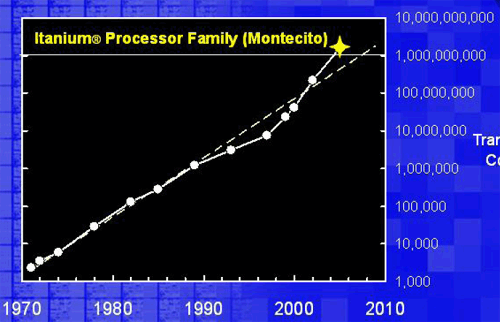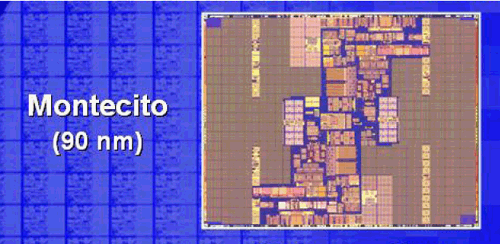Intel 65nm and Beyond (or Below): IDF Day 2 Coverage
by Kristopher Kubicki on September 9, 2004 9:26 AM EST- Posted in
- Trade Shows
Intel 65nm and Beyond (or Below)
Earlier this year we saw our first glimpse at 90nm technology with the launch of Intel's Prescott Pentium 4. Even more recently we have seen 90nm processes show up on server and workstation CPUs, like Nocona. Yet while 90nm processes are just showing up on the market in full force, Intel already has massive plans for pushing technology even farther, with roadmaps ramping to the 32nm stage by 2009. The technologies and strategies to get them there are surprisingly well documented and explained.
The talk of Fall IDF 2004 Day 1 and Day 2 was that of Moore's law; the philosophy put forth that transistor count on a processor doubles every 18 to 24 months. Near the end of our Day 1 Keynote, we got our first look at Montecito, Intel's 90nm IA64 processor with an astounding 24MB of L3 cache. Understanding how Intel is capable of placing 1.72 billion transistors on single chip is certainly a not a simple task; but Intel was kind enough to provide us with a plethora of details on how we can cram billions of transistors on a chip, and how we will continue to uphold Moore's law in the future.
First, a quick look at how Intel has upheld Moore's law:

With the introduction of Montecito, Intel surpassed Moore's law very slightly with massive banks of cache. We will go into more detail about cache and SRAM in a little bit, but in the meantime we have an image of what the processor core actually looks like.











21 Comments
View All Comments
RyanVM - Thursday, September 9, 2004 - link
I'm trying to figure out if you guys are using "Itanimum" because you're trying to be witty or just don't know that its name is "Itanium". I think my sarcasm meter might be broken.mrmorris - Thursday, September 9, 2004 - link
Interesting article, looking forward to getting "the big picture" when Intel competite technology is included (AMD).PrinceGaz - Thursday, September 9, 2004 - link
1T-SRAM is basically DRAM with a built in controller that handles all the refreshing etc, so it can be used in a similar way to SRAM.Because it uses DRAM technology, its nowhere near as fast as true SRAM and therefore unsuitable for use as cache memory.
Skykat - Thursday, September 9, 2004 - link
As I recall, the Nintendo Gamecube uses 1T-SRAM (1 transistor). Whatever happened to this technology? It would seem a lot more efficient than 6 Transistor SRAM. I think the Gamecube processor was manufactured by IBM though...ncage - Thursday, September 9, 2004 - link
#5 speed is NOT the ideal thing for what itanimum was made for. Itanimum is made for high end servers where caching is just as important as speed. Think of the high end scientific apps where the majority of the work is swapping data back and forth from ram to peform calculations on. Ya they could speed up the cpu but it would be cache starved and would be ide wile it was waiting to fetch data from main memory into cache/registers. Lots of cache is also ideal for large database appliations. One thing i am suprised is intel has not decided to go with an on die memory controller like AMD.mkruer - Thursday, September 9, 2004 - link
When I said double up on the logic I meant parallel processing, not making the logic more complex.mkruer - Thursday, September 9, 2004 - link
I will not say that I am disappointed, but I think I could sum this article up much faster, Intel has Awesome FAB capabilities, but too bad their chip designs are not the greatest. One day Intel might lean that instead of throwing huge amounts of cache to get everything to work faster, to double up on the logic. Just imagine if the Itanimum was cache efficient, with the amount of chip real-estate they could save they could easily double the core logic, and get a true boot in performance.nourdmrolNMT1 - Thursday, September 9, 2004 - link
i agree with number 3.MIKE
CrimsonDeath - Thursday, September 9, 2004 - link
Wow i feel really stupid right now...Johnmcl7 - Thursday, September 9, 2004 - link
Yeah, I fully agree I was a little disappointed the article seemed to end rather abruptly, however it was an interesting read otherwise.Also, shouldn't it be 'extensions of Moore's Law' rather than 'extentions'?
John